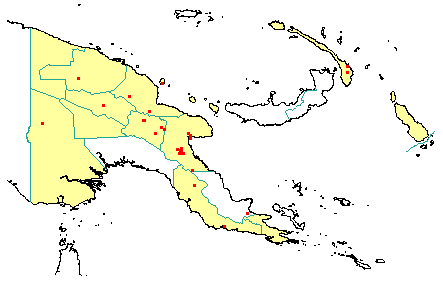
in PNGplants database
PNGTreesKey – Prunus schlechteri (Koehne) Kalkman |
Barry Conn (NSW) & Kipiro Damas (LAE).
Guide to trees of Papua New Guinea
Copyright held by the authors, National Herbarium of New South Wales, and Papua New Guinea National Herbarium
Blumea Vol. 13: 79 (1965)
Other Literature: C. Kalkman, Flora Malesiana, Series 1 345-346 (1993)
Family: Rosaceae
Dicotyledon
Timber Group: Occasional timber species
Field Characters: Large canopy tree (up to 47 m high) or Small sub-canopy tree (up to 20 m high); Bole cylindrical (up to c. 75 cm diam.); straight (bole mostly 10-20 m long); buttresses buttresses present (sometimes buttresses 0.3-0.4 m high) or buttresses absent; spines spines absent; aerial roots aerial roots absent; stilt roots stilt roots absent; Bark grey or brown (often dark brown), rough, pustular, lenticels elongated vertically; Subrhytidome (under-bark) brown, red, or green; less than 25 mm thick, 7.0-15.0 (-20.0); bark blaze consisting of one layer; strongly aromatic; almond-like (sometimes described as similar to the odour of benzoic acid); outer blaze red (pale (sometimes dark red) or slightly brown, with stripes, very fibrous; inner blaze red (pale (sometimes dark red) or slightly brown, with stripes, very fibrous; bark exudate (sap) present or absent, colourless, not readily flowing (spotty), colour changing on exposure to air, to dark red, not sticky; terminal buds not enclosed by leaves.
Indumentum: Complex hairs absent; stinging hairs absent; mature twig indumentum (hairs) present, hairs dense.
Leaves: Leaves spaced along branches, spiral (leaves occurring singly at a node and arranged spirally up the branchlet), simple (a leaf composed of a single blade); petiole present, not winged, attached to base of leaf blade, not swollen; leaves broadest at or near middle or sometimes equally broad throughout much of length, 6.0-17.0 (-20.0) cm, (2.0-) 3.0-8.0 (-10.0) cm; symmetric, entire, not dissected or lobed, obtuse, sub acute, or acuminate, venation pinnate, secondary veins open, prominent, intramarginal veins absent; leaves lower surface pale green, upper surface dull green, indumentum (hairs) absent (upper surface of old leaves) or present, indumentum (hairs) sparse (lower surface); absent or present (when present, 2-6 flat basal glands); domatia absent; stipules present, free, laterally placed, not encircling the twig, scale-like, fringed (hairy over entire surface), large (c. 6 mm long, c. 4 mm wide at base), not persistent.
Flowers: Inflorescence on the trunk or branches, flowers on an unbranched axis, cones absent; flowers bisexual, stalked (shortly), flowers with many planes of symmetry, 6.0-10.0 mm long, diameter large (more than10 mm diam.) (c. 15 mm diam.); perianth present, with distinct sepals and petals whorls, inner perianth yellowish green or yellow (pale (cream-coloured); 7-13, free or some or partly joined (by misinterpretation (sepals and petals joined to mouth of floral tube); stamens 15-40, present, free of each other, free of the perianth or joined to the perianth (by misinterpretation (stamens joined to mouth of floral tube, separate from the petals and sepals); ovary superior, carpels joined (when more than one); styles solitary, 1.
Fruits: Infrutescence arranged on unbranched axis, fruit 9.0-16.0 mm long, 14.0-16.0 mm diam., dark red, black, or purple, not spiny, fleshy, simple, indehiscent, drupe; seeds 1-2, to about 5 mm long, not winged, broad (as wide as long) (testa hairy), seed 1-10 mm diam. (c. 4 mm diam.).
Distribution: West Sepik, East Sepik, Madang, Morobe, Western Highlands, Eastern Highlands, Southern Highlands, Western, Central, Milne Bay, New Ireland & Bougainville.
 | Botanical records in PNGplants database |